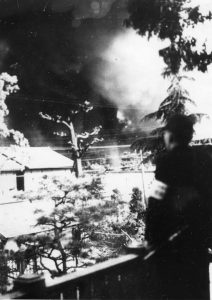Documenting Hiroshima of 1945: US air raid in April led to expanded demolition of buildings
Aug. 5, 2024
In the early morning of April 30, 1945, a U.S. military B29 bomber attacked the city of Hiroshima. It dropped 10 bombs near a warehouse of Chugoku Haiden (present-day Chugoku Electric Power Company) in the area of Komachi (now part of Hiroshima’s Naka Ward), close to the Prefectural Girls’ School. Fujie Yoneda noted in her diary that, “Columns of black smoke were rising into the air” when she had arrived at school.
It was the first time that a B29 had bombed the city’s center. Yoshito Matsushige, a former staff photographer for the Chugoku Shimbun who died in 2005 at the age of 92, rushed to the scene on his bicycle and took photographs of the burning warehouse. Tamie Sato, 90, a resident of Hiroshima’s Naka Ward who lived near the site of the bombing, looked back at that time. “Following a huge roar, all the glass doors of my house shattered. It was truly terrifying,” said Ms. Sato.
According to damage reports put out by the Hiroshima Prefectural government, the bombing left 10 people dead and five buildings incinerated. Following a directive from Japan’s Ministry of Home Affairs, the prefectural government had been working on demolishing buildings in the central part of the city since late 1944, and with the bombing, that work became even more urgent. Many first-year students from junior high schools and girls’ schools were mobilized starting in May 1945 to do the work. Buildings in targeted areas were forcibly demolished.
The main objective was to prevent fires from spreading to facilities critical to the war effort and create an “air-defense city” that could survive air attacks. Before that, on April 1, U.S. forces had landed on Okinawa’s main island. Hiroshima, a city in which military facilities were concentrated, served as the base for western Japan’s preparations for a decisive battle on the country’s mainland. On April 7, the Second General Army Headquarters, overseeing the numerous military forces in western Japan, had been established in the city.
Some school officials raised concerns and voiced their opposition to the mass mobilization of students for outdoor work that would make evacuation difficult during air raids. A former prefectural employee involved in the mobilization revealed the problem in a journal. However, the employee indicated that, in discussions, the military official in charge strongly urged those opposed to agree with the plan.
Starting on August 3, orders were given daily to mobilize 15,000 student corps members and 30,000 volunteer army corps members formed of local communities and work areas. As a result, many citizens experienced the atomic bombing without any shielding in the central part of the city, close to the hypocenter.
(Originally published on August 5, 2024)
It was the first time that a B29 had bombed the city’s center. Yoshito Matsushige, a former staff photographer for the Chugoku Shimbun who died in 2005 at the age of 92, rushed to the scene on his bicycle and took photographs of the burning warehouse. Tamie Sato, 90, a resident of Hiroshima’s Naka Ward who lived near the site of the bombing, looked back at that time. “Following a huge roar, all the glass doors of my house shattered. It was truly terrifying,” said Ms. Sato.
According to damage reports put out by the Hiroshima Prefectural government, the bombing left 10 people dead and five buildings incinerated. Following a directive from Japan’s Ministry of Home Affairs, the prefectural government had been working on demolishing buildings in the central part of the city since late 1944, and with the bombing, that work became even more urgent. Many first-year students from junior high schools and girls’ schools were mobilized starting in May 1945 to do the work. Buildings in targeted areas were forcibly demolished.
The main objective was to prevent fires from spreading to facilities critical to the war effort and create an “air-defense city” that could survive air attacks. Before that, on April 1, U.S. forces had landed on Okinawa’s main island. Hiroshima, a city in which military facilities were concentrated, served as the base for western Japan’s preparations for a decisive battle on the country’s mainland. On April 7, the Second General Army Headquarters, overseeing the numerous military forces in western Japan, had been established in the city.
Some school officials raised concerns and voiced their opposition to the mass mobilization of students for outdoor work that would make evacuation difficult during air raids. A former prefectural employee involved in the mobilization revealed the problem in a journal. However, the employee indicated that, in discussions, the military official in charge strongly urged those opposed to agree with the plan.
Starting on August 3, orders were given daily to mobilize 15,000 student corps members and 30,000 volunteer army corps members formed of local communities and work areas. As a result, many citizens experienced the atomic bombing without any shielding in the central part of the city, close to the hypocenter.
(Originally published on August 5, 2024)








